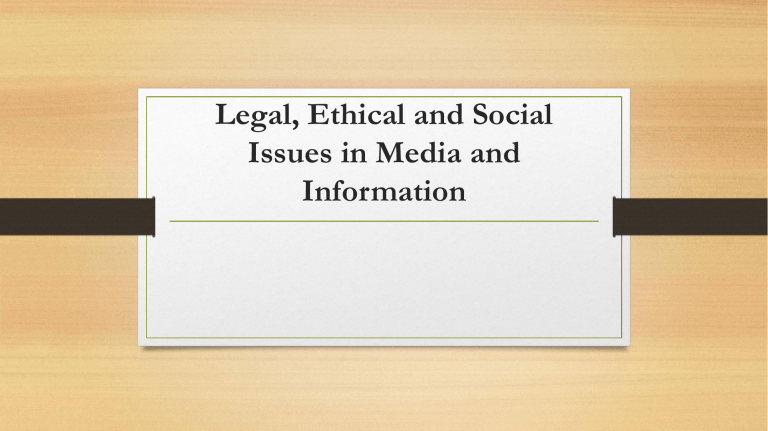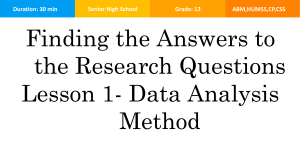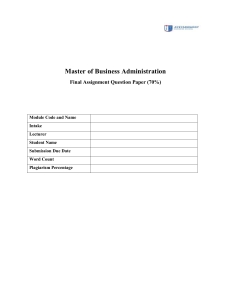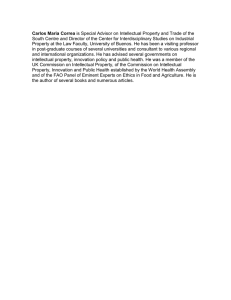
Legal, Ethical and Social Issues in Media and Information What is Media Law? Media Law is a legal field that relates to legal regulation of the telecommunications industry, information technology, broadcasting, advertising, the entertainment industry, censorship, and the internet and online services among others (Media Law – HG.org, 2017). Media Law Media law covers a lot of aspects of media, regardless of its form. Its concerns range from Intellectual Property, Free Speech and Censorship to Defamation and Right to Privacy. Media Law and the Freedom of Expression As indicated in the earlier lessons, media played an important role in a democratic society as the Philippines. The 1987 Constitution had taken note of the importance of freedom of expression, hence the Article III, Section 4 has been created: “No law shall be passed abridging the freedom of speech, of expression or of the press, or the right of people peaceably to assemble and petition the government for redress of grievances.” Media Law and the Freedom of Expression This, just like most of our laws, is substantially similar to the First Amendment of the US Constitution (Viduya, 2010): “The Congress shall make no law respecting an establishment of religion, or prohibiting the free exercise thereof, or abridging the freedom of speech, or of the press.” What is Intellectual Property? Intellectual property is a category of property that includes intangible creations of the human intellect. Intellectual Property Rights According to the Republic Act 8293, also known as the Intellectual Property Code of the Philippines, the term intellectual property rights consist of the following: • • • • • • • Copyright and related rights; Trademarks and service marks Geographic indications Industrial desings Patents Layout-designs (topographies) or integrated circuits Protection of undisclosed information (n. TRIPS) Copyright One of the biggest problems faced by those in the field of Media law are copyright concerns. Copyright can be defined as “a form of intellectual property which protects the rights of authors and creators of artistic works. It refers to the main act in which, in respect of literary and artistic creation, may be made only by the author or with his authorization” (Copyright, National Library of the Philippines website, 2011). Copyright protects ownership rights to intellectual property and covers a lot of areas. This can be in the form of original works and trademarks for different brands. It is also applicable to patents for media-related technologies or processes (Media Law – HR.org, 2017). In the Philippines, works covered by copyright include but are not limited to the following: • • • • • • • • Literary works such as novels, poems and plays Newspaper articles Films and television programs Letters Artistic works (paintings, sculptures, drawing and photographs) Architecture Computer programs Advertisements, maps and technical drawings 2 types of Copyright The Economic rights- Give the author or copyright owner the right to derive financial reward from his works by others. The Moral Rights- refer to the author’s right to claim authorship of the work (known as Right of Paternity) and restrain the use of his name with respect to any work not of his own creation or a distorted version of his work. Plagiarism Another issue that related to intellectual property is plagiarism. Plagiarism is generally defined as passing off someone else’s creative work as your own, without permission (Vivian, 2010). But this issue is more serious than one would often assume. According to the Merriam-Webster online dictionary, the act of plagiarism can mean any of the following (What is Plagiarism? From: plagiarism.org) : To steal and pass off (ideas or words of another) as one’s own; To use (another’s production) without crediting the source; To commit literary theft; and, To present as new and original an idea or product derived from an existing source. Fair Use Generally speaking, fair use refers to any copying of copyrighted material done for a limited and “transformative” purpose, such as to comment upon, criticize, or parody a copyrighted work (Standford University Libraries, 2017). This can be done without the copyright owner’s permission, hence it is often used as a defense against a claim of copyright infringement. Fair use follows general guidelines and varied court decisions, which makes its definition seem vague. This is due to the fact that judges and lawmakers who created fair use exception did not want to limit its definition – instead it has an expansive meaning which is open to interpretation. Nevertheless, fair use is often classified into two categories: 2 Categories of Fair use 1. Commentary and Criticism-Fair use principles allows you to reproduce come parts of the copyrighted work in order to comment upon or critique it. A good example of this would be writing a book review. You may summarize or quote parts of the copyrighted work to use in commentary and criticism. 2. Parody – a parody is generally defined as a work that that aims to ridicule another, usually well-known work (Standford University Libraries, 2017). This means that parodies requires some taking from the original work which is being parodied. Netiquette • Netiquette is short for Internet etiquette or network etiquette. Simply put, this term refers to the use of good manners in online communication. The Core Rules of Netiquette Rule 1: Remember the Human-Do unto other as you’d have others do unto you, has always been the Golden Rule which has been taught to us since we were children. Rule 2: Adhere to the same standards of behavior online that you follow in real life-What people must always keep in mind is that standards of behavior followed in real life can be applicable online. Rule 3: Know where you are in cyberspace-It is important to keep in mind that Netiquette varies from domain to domain. Rule 4: Respect other people’s time and bandwidth-When it comes to communicating online, it is important to be considerate of other people’s time. Another thing to keep in mind is the bandwidth. According to Merriam Webster, bandwidth refers to the capacity for data transfer of an electronic communications system. Rule 5: Make yourself look good online-Always remember that when you are online, you’d encounter lots of people whom you have never met before. As such, it is best to make a good impression. Rule 6: Share expert knowledge-One of the advantages of online communication is that it allows you to gather information from various experts on specific topics. Rule 7: Help keep flame wars under control-Perpetuation of flame wars – series of angry messages, mostly from two or more people directed toward each other. Rule 8: Respect other people’s privacy-Everyone has a right to privacy. That includes the privacy in the cyberspace. Rule 9: Do not abuse your power-having more power than other people does not give them right to take advantage of them. Rule 10: Be forgiving of other people’s mistakes-Always remember that nobody’s perfect. It is best to be considerate of other people’s mistakes – whether it’s an error in spelling and grammar, or if it’s a senseless question or response. Threats, Risk, Abuse, and Misue of Media, Information, and Technology THREATS Refer to the exploitation of vulnerability, both intentionally or accidentally, resulting in damage. Cyberbullying Cyberbullying is bullying that takes place using electronic technology such as cell phones, computers, and tablets as well as communication tools including social media sites, text messages, chat, and websites (StopBullying.gov, 2017). MEDIA AND TECHNOLOGY DEPENDENCE Media and technology are so that we do not notice there presence. Sometimes, because of our dependence on them, we seem to fail to perform material functions without them. We seem to be disempowered when we are put into a position where media and technology are not available. INFORMATION AND CYBER SECURITY A continuous threat to anyone using the internet, falling into the threats of information and cyber security is inevitable. The information that we share online can be used for extortion, hacking, or cyber theft. CYBERWARFARE This is hacking taken to the next level, where malicious computer virus can gather information and access organizational and even government system to launch cyberattacks by using these intelligences. DIGITAL DIVIDE As noted by Prensky (2001), you are digital natives and those came before you are digital immigrants. With the changes of technology, digital natives become more and more comfortable with technology, while digital immigrants may find it hard to catch up. Despite the easier access to computers and to the internet, there remains the digital divide between the rich and the poor. RISK Refers to destructions of assets when vulnerabilities are exploited through threats. RELATIONSHIPS With opportunities for virtual communication, relationships are said to be established or stronger. However, another perspective is that the progress in technology have isolated us. CULTURAL HERITAGE Media and technology also carry information that promotes cultural heritage, such as virtual museums and tours. SOCIO-POLITICAL SYSTEMS Media, information, and technology redefine socio-political systems because they become a power struggle between those who have the power to control these and the masses. ABUSE Refers to the intentional overuse of media, information, and technology to the point it becomes harmful to the individual user and even to others. INTERNET ADDICTION While exposure to the internet is helpful in many ways, to much internet consumption can lead to addiction. INFORMATION MANIPULATION Information carries so much power that it can be controlled toward the purpose of disinformation. PROPAGANDA When information is manipulated or controlled with the purpose of influencing public opinion through deliberated dissemination, it becomes propaganda. Information is the name of the game, and people in power tend to use it in their favor. MISUSE Refers to the wrongful use of media, information, and technology without the persons knowledge that what they are doing is already wrong and harmful. PLAGIARISM AND COPYRIGHT INFRINGEMENT The easy access to information in various media and technology forms can raise issues on intellectual property. People can easily copy-paste, download, or record information made available to them online and then claim them as their own and even generate profit from it. FAKE NEWS People tend to misuse information when they read, share, and even apply fake news without them realizing it. CALLOUT AND CANCEL CULTURE Online shaming has become pervasive in the social media space through callout and cancel culture. THANK YOU FOR LISTENING




